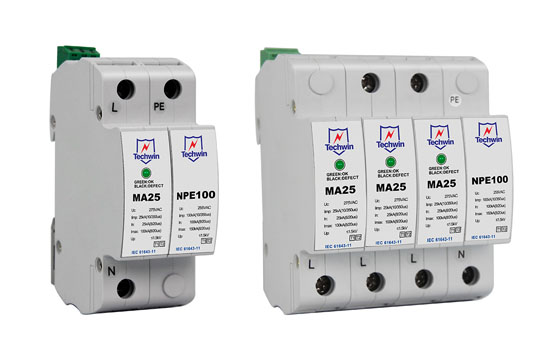In modern biogas facilities, biogas, as a clean and renewable energy source, is being widely used globally. However, for biogas plants, which process organic materials and produce biogas, the safe operation of internal equipment is crucial. Particularly under adverse weather conditions such as lightning and surges, safety protection of biogas plants is especially important. This article will explore the role of lightning and surge protection devices in biogas plants.
Lightning surge protection devices are not optional but are basic facilities mandated by various global regulations and safety standards, emphasizing the urgent need to protect life, property, and electronic equipment from the destructive effects of lightning and voltage spikes. Following international standards, such as Europe's IEC 62305, lightning protection systems are not only a legal obligation but also a fundamental responsibility. Compliance with these standards ensures that buildings are equipped with certified lightning surge protection devices, providing comprehensive protection to prevent structural damage, electronic equipment failures, and fires caused by lightning.
Lightning surge protection devices primarily function by introducing electromagnetic pulses, such as lightning and surges, into the ground, thus protecting electrical equipment inside the biogas plant from damage. These devices typically include lightning rods, down conductors, and grounding grids, which can effectively direct lightning energy into the ground and reduce its impact on the plant's equipment. Additionally, lightning surge protection devices can also suppress voltage spikes caused by grid fluctuations and switching operations, ensuring the stable operation of equipment within the biogas plant.
In biogas plants, the application of lightning surge protection devices is mainly reflected in the following areas:

Main power line protection: Install Type 1 surge protection devices (SPD) on the main 1/230 AC power line at the low-voltage distribution board in the biogas plant, to withstand impulse currents of up to 25kA (10/350 μs). Type 2 surge protection devices are installed on the downstream sub-distribution boards. TheseSPDs have strong protection capabilities and can effectively prevent lightning and surges from damaging electrical equipment.
CHP (Combined Heat and Power) distribution panel protection: Modular multipole combined surge protection devices are installed at the CHP distribution panels to withstand overcurrent. These SPDs can ensure the stable operation of CHP facilities under adverse weather conditions like lightning and surges.
Terminal equipment protection: Install SPDs within a 5-meter range of the load to provide additional protection for terminal equipment. This can ensure that terminal equipment within the biogas plant is protected from electromagnetic pulses such as lightning and surges.
To ensure the effectiveness of lightning surge protection devices within the biogas plant, remote monitoring systems are needed. Such systems can monitor the operating status of electrical equipment, control systems, and other key equipment in real-time, and promptly detect and handle the impact of electromagnetic pulses like lightning and surges on the equipment. Through remote monitoring systems, operators can quickly identify and resolve issues, ensuring the stable operation and production safety of the biogas plant.
In conclusion, lightning surge protection devices are indispensable safety protection measures for biogas plants. By rationally selecting and installing these devices, and combining them with the application of remote monitoring systems, the safe operation and stable production of biogas plants under adverse weather conditions like lightning and surges can be ensured.
 Surge Protector for Closed-Circuit Television SystemJune 26, 2024This article will introduce the importance and working principle of surge protector for CCTV that meet the high availability requirements of closed-circuit television systems.The Necessity of Surge Pr...view
Surge Protector for Closed-Circuit Television SystemJune 26, 2024This article will introduce the importance and working principle of surge protector for CCTV that meet the high availability requirements of closed-circuit television systems.The Necessity of Surge Pr...view What Is a Transient Voltage Surge Suppressor (TVSS)?June 26, 2024Transient Voltage Surge Suppressor (TVSS) is a device used to protect electronic equipment from transient overvoltage, spikes, or surges. With the increasing reliance on network infrastructure due to ...view
What Is a Transient Voltage Surge Suppressor (TVSS)?June 26, 2024Transient Voltage Surge Suppressor (TVSS) is a device used to protect electronic equipment from transient overvoltage, spikes, or surges. With the increasing reliance on network infrastructure due to ...view Understanding Your Needs: A Guide to Selecting the Perfect Surge ProtectorMarch 1, 2024In an era dominated by electronic devices, protecting them from power surges is crucial. A surge protector acts as a guardian, shielding your valuable equipment from sudden voltage spikes. However, no...view
Understanding Your Needs: A Guide to Selecting the Perfect Surge ProtectorMarch 1, 2024In an era dominated by electronic devices, protecting them from power surges is crucial. A surge protector acts as a guardian, shielding your valuable equipment from sudden voltage spikes. However, no...view Common Signal Surge Protective Devices and Their Industry ApplicationsOctober 9, 2024What is a Signal Surge Protective DeviceA signal surge protective device is an electronic device that protects instruments, equipment, or systems on the signal line from damage caused by lightning str...view
Common Signal Surge Protective Devices and Their Industry ApplicationsOctober 9, 2024What is a Signal Surge Protective DeviceA signal surge protective device is an electronic device that protects instruments, equipment, or systems on the signal line from damage caused by lightning str...view Terms and definitions of IEC 61643-11: LOW-VOLTAGE SURGE PROTECTIVE DEVICES (2/2)December 8, 2022the professional explanation of main terms of surge protective devicesview
Terms and definitions of IEC 61643-11: LOW-VOLTAGE SURGE PROTECTIVE DEVICES (2/2)December 8, 2022the professional explanation of main terms of surge protective devicesview Surge Protector: Guardian of Thunderstorm WeatherMarch 13, 2023During the high-frequency thunderstorm season, the unstable weather brings not only inconvenience to people's travel but also poses potential safety hazards. Lightning waves can be introduced with...view
Surge Protector: Guardian of Thunderstorm WeatherMarch 13, 2023During the high-frequency thunderstorm season, the unstable weather brings not only inconvenience to people's travel but also poses potential safety hazards. Lightning waves can be introduced with...view